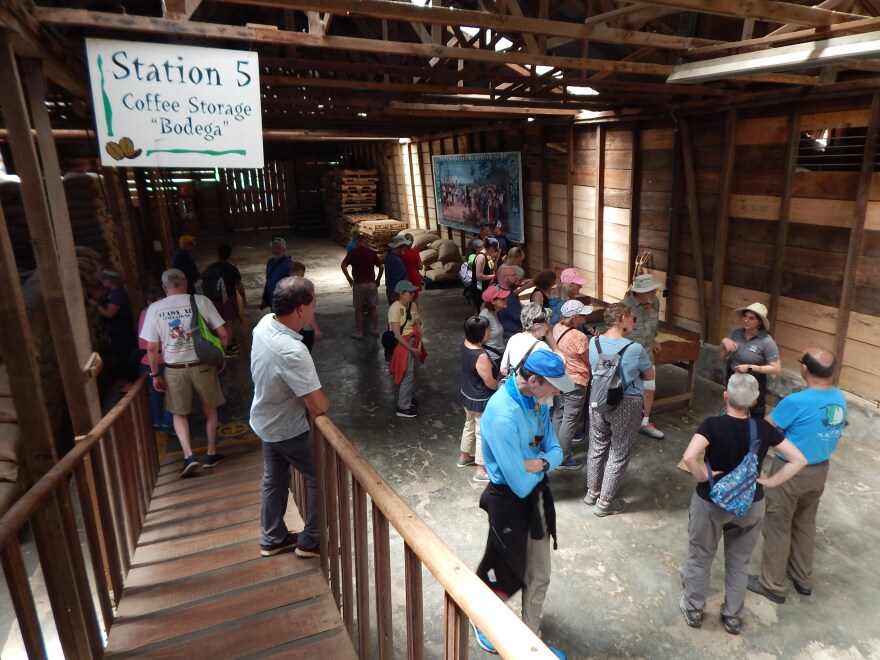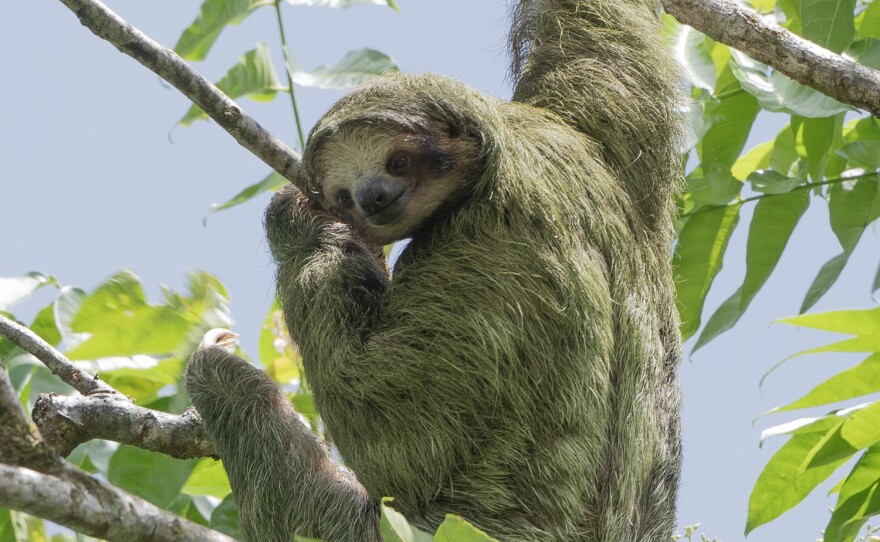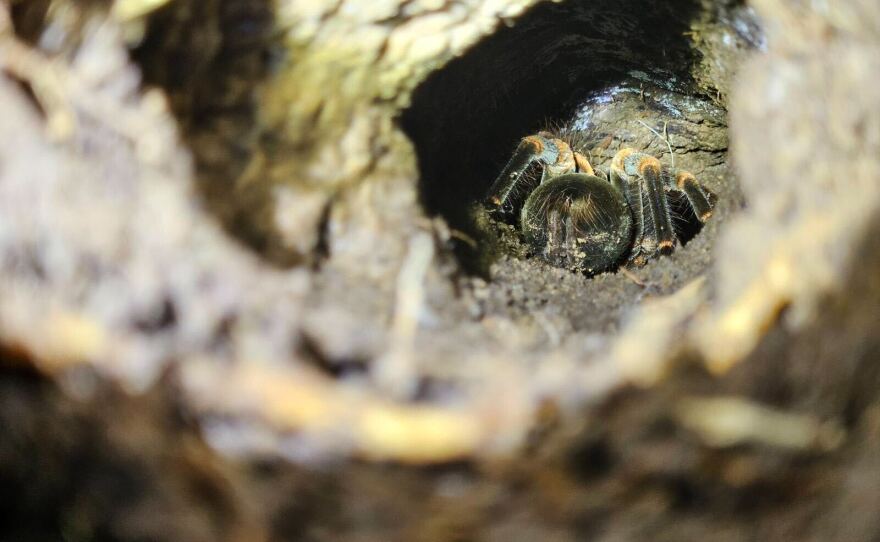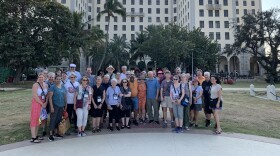“Pura Vida”: it’s a phrase we heard often during our adventurous journey in Costa Rica, but it’s really more of a feeling. Although it literally means “pure life,” Pura Vida is quintessential Costa Rican vernacular that evokes the carefree, optimistic lifestyle of the country, and one that listeners were able to embrace with the help of our incredible guide, Minor Alfaro.
Minor took 33 Michigan Public travelers from Liberia to the side of an active volcano (Rincón de la Vieja) to the cloud forests and hanging bridges of Monteverde, to the stunning Pacific coast to a coffee farm near San José. All along the journey, we embraced Pura Vida by taking pleasure in the simple things: scarlet macaws flying along the Pacific shore, a fresh cup of Costa Rican coffee, and giant blue butterflies landing on our heads.

On day one, we all piled into the bus on what Minor affectionately called “interesting roads” (i.e. bumpy, winding roads over so-called "OMG bridges") to stay at the Blue River Resort. The next morning Minor took us on a walk through the lush grounds, which include a butterfly garden teeming with huge Blue morphos, dipping pools fed by natural hot springs, and a relaxing natural sauna. We had our first sloth sighting here, too!
Some members of our group also happened upon a large bullet ant, which is known for its extremely painful sting.

We were free to roam the lush botanical, hummingbird, and butterfly gardens — or soak in the hot springs — for the rest of the day, resting our bones after lots of traveling. At around four in the morning, a drenching rain swept through. It was pretty cool to hear it on the tin roofs of our cabins.
Then, we headed to Monteverde in the cloud forest region, where we spent the next few days. We learned that cloud forests are among the most biodiverse ecosystems on the planet, with thousands of species of plants, especially epiphytes: plants like ferns, bromeliads and orchids that grow on other plants like large trees. One tree in the cloud forest can host over 300 different epiphyte species.
On the way to Monteverde, we paused for an exciting rafting trip where we observed crocodiles, howler monkeys, ospreys, proboscis bats, iguanas and the famous “Jesus Christ” lizard, which appears to walk on water as it quickly skitters away from threats. Halfway through the trip, we took a break on the riverbank and enjoyed cold pineapple and watermelon with our guides.
After another winding drive up into the mountains, we reached the El Establo Mountain Hotel in Monteverde. Coatimundi – animals related to raccoons with extremely long tails – roamed the grounds, and we could see all the way to the Bay of Nicoya from our balconies, which made for some stunning sunsets.
We visited a hummingbird garden in the region to observe some of Costa Rica's more than fifty species of hummingbirds. We saw the stunning violet sabrewing, the coppery-headed emerald, and the metallic green-crowned brilliant, pictured below.

The next day's journey took us high up into the Monteverde rainforest canopy. Some of our travelers chose to stay on solid ground and explored the incredible sloth sanctuary. We’d spent days getting slight glimpses through telescopes and camera lenses of sloths high up in the trees, so being able to see them up close was a magical experience.
The rest of the group took a journey up to the eight hanging bridges of the cloud forest canopy - also quite magical. The bridges got longer and higher up as we went — reaching more than 515 ft long and 110 ft high — and made for some unforgettable memories...and a few gasps of fear when the bridges began to sway! We also got to take a peek at some sleeping critters in the forest: sac bats resting in a hollow log, and a female red-legged tarantula who our guide said had been living in the same burrow for six years. We listened to the strange, mechanical song of the three-wattled bellbird echo through the forest and took in the thousands of unique plant species around us. It was certainly a walk to remember.
After the cool, breezy climate of Monteverde, we traveled to Quepos on the Pacific Coast, a town home to beautiful ocean views and a much hotter, more humid climate. We spent the morning at Manuel Antonio National Park, where we saw capuchin and howler monkeys and three-toed sloths. Part of our group had the unusual experience of witnessing a capuchin monkey steal a baby howler monkey…and eat it. The guides told us it was a pretty rare (and let us tell you, unforgettable) thing to see.
After our tour of the national park, many of us opted to take a refreshing dip in the calm waters off of Manuel Antonio Beach. Floating in the cool ocean felt amazing after walking in the heat of the jungle. As we were leaving the beach, Minor spotted a giant parrot snake weaving in and out of a palm frond.

Some members of our group opted to take guided night walks in the area to see a different cast of wild characters.
It will be hard to forget the sounds of the jungle at night: at least five species of frogs chirping, trilling, and singing, bats echo locating, and tons of insects communicating throughout the forest. Right as we began our walk we spotted a kinkajou — a nocturnal, arboreal mammal related to raccoons — swinging high in the trees.
Our guide Edgardo was very excited as he said the animal isn’t spotted that often. It was a good sign for what was to come during the rest of the walk: bark scorpions that turned bright purple under the shine of a UV light, the iconic red-eyed tree frog, hundreds of busy leaf-cutter ants carrying leaves and flowers, and the highlight of the night: an Eyelash pit viper. This small, venomous snake isn’t very easy to spot, so we were quite lucky! Some members of the group were more excited about the viper than others. We finished the night with a home-cooked meal of arroz con pollo as we reviewed all the fascinating critters we’d seen.
After two days in Manuel Antonio, we were off to San José: the capital and largest city of Costa Rica. Along the way, we visited an ox cart factory that had been turned into a museum. Ox carts — called carretas in Spanish — in Costa Rica are known for their bright colors and intricate patterns. They were once a main form of transportation and are now considered a traditional and celebratory icon in the country.
Our last full day included a brief trip to Poás Volcano National Park, where we visited the crater, which is the largest active crater in the world. Because of the noxious gases, we were only allowed to spend about 20 minutes around the crater.

After the volcano visit, we toured the lush coffee fields at Hacienda Doka. We learned about the fascinating processes behind traditional coffee production while experiencing the serene beauty of the coffee farm. The samples weren't bad, either: we especially enjoyed the iced coffee with chocolate and cinnamon.

Every day was an adventure on this trip. We enjoyed getting to know one another in such stunning settings, sharing meals of traditional casado (rice, black beans, plantains, salad, a tortilla, and a protein), and working together to spot sloths, unique flowers, and exotic birds. Our guides throughout the journey were marvelous, enhancing our experience and sharing all the best parts of their country with us. From the valley of a volcano to the canopy of the cloud forest and all of the exciting stops between, we lived by "Pura Vida" and will carry the feeling with us for a long time.
To find out about future Michigan Public listener trips — including Cuba in November 2024 — click here.































